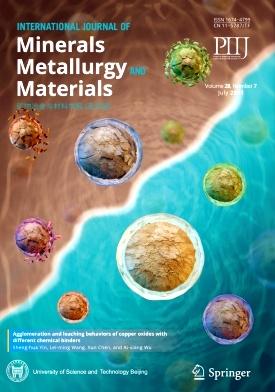Comparison of the effects of Ti- and Si-containing minerals on goethite transformation in the Bayer digestion of goethitic bauxite
Abstract
Goethitic bauxite is a widely used raw material in the alumina industry. It is an essential prerequisite to clarify the effect of Ti- and Si-containing minerals on goethite transformation in the Bayer digestion process, which could efficiently utilize the Fe- and Al-containing minerals present in goethitic bauxite. In this work, the interactions between anatase or kaolinite with goethite during various Bayer digestion processes were investigated using X-ray diffraction (XRD), X-ray photoelectron spectroscopy (XPS), transmission electron microscopy (TEM), and scanning electron microscopy (SEM). The results showed that anatase and kaolinite hindered the transformation of goethite. Anatase exerted more significant effects than kaolinite due to the dense sodium titanate layer on the goethite surface after reacting with the sodium aluminate solution. Adding the reductant hydrazine hydrate could eliminate the retarding effect by inducing the transformation of goethite into magnetite. In this process, titanium was embedded into the magnetite lattice to form Ti-containing magnetite. Furthermore, the weakening of the interaction between magnetite and sodium aluminosilicate hydrate reduced the influence of kaolinite. As a validation of the above results, the reductive Bayer method resulted in the transformation of goethite into goethitic bauxite with 98.87% relative alumina digestion rate. The obtained red mud with 72.99wt% Fe2O3 could be further utilized in the steel industry. This work provides a clear understanding of the transformative effects of Ti- and Si-containing minerals on iron mineral transformation and aids the comprehensive use of iron and aluminum in goethitic bauxite subjected to the reductive Bayer method.

 求助内容:
求助内容: 应助结果提醒方式:
应助结果提醒方式:


